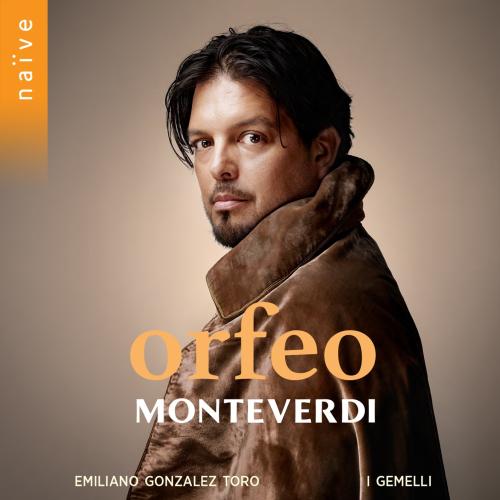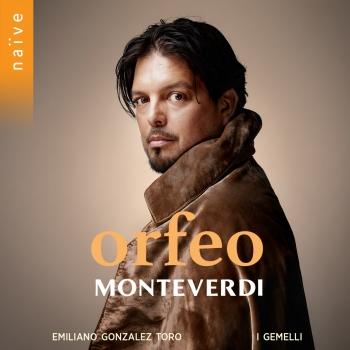
Monteverdi: L'Orfeo Emiliano Gonzalez Toro & I Gemelli
Album Info
Album Veröffentlichung:
2020
HRA-Veröffentlichung:
30.10.2020
Label: Naïve, a Label of Believe Group
Genre: Classical
Subgenre: Opera
Interpret: Emiliano Gonzalez Toro & I Gemelli
Komponist: Claudio Monteverdi (1567–1643)
Das Album enthält Albumcover Booklet (PDF)
Entschuldigen Sie bitte!
Sehr geehrter HIGHRESAUDIO Besucher,
leider kann das Album zurzeit aufgrund von Länder- und Lizenzbeschränkungen nicht gekauft werden oder uns liegt der offizielle Veröffentlichungstermin für Ihr Land noch nicht vor. Wir aktualisieren unsere Veröffentlichungstermine ein- bis zweimal die Woche. Bitte schauen Sie ab und zu mal wieder rein.
Wir empfehlen Ihnen das Album auf Ihre Merkliste zu setzen.
Wir bedanken uns für Ihr Verständnis und Ihre Geduld.
Ihr, HIGHRESAUDIO
- Claudio Monteverdi (1567 - 1643): L'Orfeo, SV 318:
- 1 L'Orfeo, SV 318: "Toccata" 01:29
- 2 L'Orfeo, SV 318: "Ritornello" 00:41
- 3 L'Orfeo, SV 318: "Prologo – Dal mio permesso amato" 05:03
- L'Orfeo, SV 318, Act I:
- 4 L'Orfeo, SV 318, Act I: "In questo lieto e fortunato giorno" (Pastore) 01:23
- 5 L'Orfeo, SV 318, Act I: "Vieni imeneo, deh vieni" (Coro) 00:38
- 6 L'Orfeo, SV 318, Act I: "Muse, onor di parnaso" (Ninfa) 00:48
- 7 L'Orfeo, SV 318, Act I: "Lasciate i monti" (Coro) 01:13
- 8 L'Orfeo, SV 318, Act I: "Ritornello" 00:19
- 9 L'Orfeo, SV 318, Act I: "Ma tu, gentil cantor" (Pastore, Orfeo, Euridice) 03:29
- 10 L'Orfeo, SV 318, Act I: "Lasciate i monti" (Coro) (2) 00:28
- 11 L'Orfeo, SV 318, Act I: "Ritornello" (2) 00:21
- 12 L'Orfeo, SV 318, Act I: "Vieni imeneo, deh vieni" (Coro) (2) 00:41
- 13 L'Orfeo, SV 318, Act I: "Ma s’il nostro gioir dal ciel deriva" (Pastore) 00:40
- 14 L'Orfeo, SV 318, Act I: "Ritornello. Alcun non sia che disperato in preda" (Pastori, Ninfe) 03:06
- L'Orfeo, SV 318, Act II:
- 15 L'Orfeo, SV 318, Act II: "Ecco orfeo" (Coro) 00:37
- 16 L'Orfeo, SV 318, Act II: "Sinfonia" 00:17
- 17 L'Orfeo, SV 318, Act II: "Ecco pur ch’a voi ritorno" (Orfeo, Pastore) 00:51
- 18 L'Orfeo, SV 318, Act II: "Ritornello. In questo prato adorno" (Due pastori) 00:48
- 19 L'Orfeo, SV 318, Act II: "Ritornello. Qui le napee vezzose" (Due Pastori, Coro) 00:59
- 20 L'Orfeo, SV 318, Act II: "Ritornello. Vi ricorda, o bosch’ombrosi" (Orfeo) 02:00
- 21 L'Orfeo, SV 318, Act II: "MIra, deh mira orfeo" (Pastore, Messaggiera, Orfeo) 08:34
- 22 L'Orfeo, SV 318, Act II: "Ahi caso acerbo!" (Coro) 01:05
- 23 L'Orfeo, SV 318, Act II: "Ma io, ch’in questa lingua" (Messaggiera) 01:08
- 24 L'Orfeo, SV 318, Act II: "Ritornello" (3) 01:09
- 25 L'Orfeo, SV 318, Act II: "Chi ne consola, ahi lassi?" (Coro) 01:38
- 26 L'Orfeo, SV 318, Act II: "Ahi caso acerbo!" (Coro, Due Pastori) 02:32
- 27 L'Orfeo, SV 318, Act II: "Ritornello" (4) 00:50
- L'Orfeo, SV 318, Act III:
- 28 L'Orfeo, SV 318, Act III: "Sinfonia" 01:10
- 29 L'Orfeo, SV 318, Act III: "Scorto da te, mio nume" (Orfeo, Speranza, Caronte) 05:45
- 30 L'Orfeo, SV 318, Act III: "Sinfonia" (2) 00:47
- 31 L'Orfeo, SV 318, Act III: "Possente spirto, e formidabil nume" (Orfeo) 09:25
- 32 L'Orfeo, SV 318, Act III: "Ben mi lusinga alquanto" (Caronte, Orfeo) 01:46
- 33 L'Orfeo, SV 318, Act III: "Sinfonia" (3) 00:50
- 34 L'Orfeo, SV 318, Act III: "Ei dorme" (Orfeo) 01:58
- 35 L'Orfeo, SV 318, Act III: "Sinfonia a 7" 00:31
- 36 L'Orfeo, SV 318, Act III: "Nulla impresa per huom si tenta invano" (Coro di spiriti infernali) 01:41
- 37 L'Orfeo, SV 318, Act III: "Sinfonia a 7" (2) 00:34
- L'Orfeo, SV 318, Act IV:
- 38 L'Orfeo, SV 318, Act IV: "Signor, quel infelice" (Proserpina, Plutone, Spiriti) 06:11
- 39 L'Orfeo, SV 318, Act IV: "Pietade, oggi" (Coro di spiriti) 00:21
- 40 L'Orfeo, SV 318, Act IV: "Ecco il gentil cantore" (Spirito) 00:10
- 41 L'Orfeo, SV 318, Act IV: "Ritornello. Qual honor di te sia degno" (Orfeo, Spiriti, Euridice) 05:05
- 42 L'Orfeo, SV 318, Act IV: "Sinfonia a 7" 00:36
- 43 L'Orfeo, SV 318, Act IV: "è la virtute un raggio" (Coro di spiriti) 01:22
- 44 L'Orfeo, SV 318, Act IV: "Sinfonia a 7" (2) 00:41
- 45 L'Orfeo, SV 318, Act IV: "Ritornello" 00:46
- L'Orfeo, SV 318, Act V:
- 46 L'Orfeo, SV 318, Act V: "Questi i campi di tracia" (Orfeo, Eco) 06:17
- 47 L'Orfeo, SV 318, Act V: "Sinfonia" 00:47
- 48 L'Orfeo, SV 318, Act V: "Perch’a lo sdegno" (Apollo, Orfeo) 03:36
- 49 L'Orfeo, SV 318, Act V: "Saliam cantando al cielo" (Apollo, Orfeo) 01:16
- 50 L'Orfeo, SV 318, Act V: "Ritornello. Vanne, Orfeo, felice a pieno" 01:01
- 51 L'Orfeo, SV 318, Act V: "Moresca" 00:49
Info zu Monteverdi: L'Orfeo
Monteverdi’s L’Orfeo - premiered in 1607 at the Ducal Palace in Mantua - is a unique masterpiece in its way of thinking and representing music that never ceases to inspire the greatest.
Emiliano Gonzalez Toro, at the heart of his ensemble I Gemelli, signs his third recording for naïve with this luxuriant reading refocused around the voice, which exalts both the aesthetics inherited from the Renaissance and the modernity of a virtuoso score.
This production, hailed on the stages of Paris and Toulouse at the end of 2019, has the singularity of being conducted ‘by the voice’ by the tenor, who plays the title role while directing singers and instrumentalists. Emiliano Gonzalez Toro displays his care - not only for himself but also for the ten soloists who surround him - with richly ornamented vocal lines that contrast in their dynamics and climates, always keeping the narration and interventions of the characters in tension.
From this fragmentation inherent in Striggio’s poem, which is also a model of proportions and balance for this favola in musica, the performers gathered here draw mobility and creativity, thanks to which recurrence is never repetitive and the pastoral scenes enhance moments of introspection such as “Rosa del cielo” (Act I), the famous “Tu se’ morta” (Act II) or the arrival of Orpheus in the Underworld in Act III (“Scorto da te”).
A continuo that is very inventive in its choice of timbres and accompaniment enriches the vocal and instrumental texture, dominated by the viols and enriched by a 1600 ceterone from the collections of the Musée de la Musique de Paris. The result is a true festive dimension, a powerful divine breath.
"[Toro's] Orfeo is remarkable for both the fluency of his singing (the coloratura flourishes in Possente Spirto fall like pearls from his larynx) and his eloquent declaiming of Monteverdi’s recitar cantando...The supporting cast is packed with superb specialists: Emöke Barath, Natalie Perez, Jérôme Varnier and Fulvio Bettini, but it’s Toro’s set." (Sunday Times)
"There are many other moments in Toro’s performance that might be highlighted, and I’m sure it will repay further study. Equally impressive is the care with which he has ensured that all his excellent cast has been carefully coached to remember the critical maxim in this music – prima le parole, poi la musica. Were it not for the lack of ornamentation this might have become my favourite version, but it is an important flaw. It is salutary that for a more stylish approach to embellishment it is necessary to go back to Nigel Rogers’ 1984 outstanding recording on EMI, interestingly another version where the Orfeo also undertook the musical direction (with Charles Medlam)." (Brian Robins, earlymusicreview.com)
I Gemelli
Emiliano Gonzalez Toro, direction
Emiliano Gonzalez Toro
The son of Chilean parents, Emiliano Gonzalez Toro was born in Geneva, where his first musical experiences were singing in the children’s choir Les pueri de Genève. He later completed his degree in oboe in Geneva and Lausanne, attaining the first-prize level before he switched to voice and undertook training with Marga Liskutin, Anthony Rolfe Johnson, and Ruben Amoretti. From the beginning of his career, Baroque music has been a repertoire focus, and Gonzalez Toro has worked with William Christie and Les Arts Florissants, Marc Minkowski and Les Musiciens du Louvre, Christina Pluhar and L’Arpeggiata, Hervé Niquet and Le Concert Spirituel, Christophe Rousset and Les Talens Lyriques, and Raphaël Pichon and the Ensemble Pygmalion. He has appeared in Cavalli’s La Callisto at the Bavarian Staatsoper, Rameau’s Platée at the Opéra National du Rhin in Strasbourg, and Verdi’s La traviata at the Festspielhaus Baden-Baden in the staging by Rolando Villazón. In the United States he has been seen in Félicien David’s opéracomique Lalla Roukh, which he performed in Washington, D.C., and New York. In the fall and winter of the 2015-16 season Emiliano Gonzalez Toro sang Eumene in Cavalli’s Xerse in performances with Emmanuelle Haïm and Le Concert d’Astrée in Lille, Vienna, and Caen; in February 2016 he appeared as the title hero in Leonardo Vinci’s Catone in Utica in Amsterdam under the direction of Andrea Marcon. Along with a variety of Baroque operas, his discography includes Monteverdi’s Vespers, Lully’s Grands Motets, works for organ and voice by C.sar Franck, and Bach’s B minor Mass. Gonzalez Toro additionally can be seen as Arnalta on a live DVD recording of Monteverdi’s L’incoronazione di Poppea under Emmanuelle Haïm from Lille.
Booklet für Monteverdi: L'Orfeo















